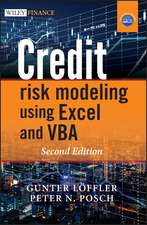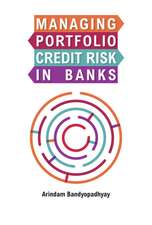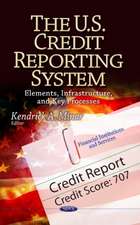Introduction to Credit Risk Modeling: Chapman and Hall/CRC Financial Mathematics Series
Autor Christian Bluhm, Ludger Overbeck, Christoph Wagneren Limba Engleză Hardback – 2 iun 2010
The recent financial crisis has shown that credit risk in particular and finance in general remain important fields for the application of mathematical concepts to real-life situations. While continuing to focus on common mathematical approaches to model credit portfolios, Introduction to Credit Risk Modeling, Second Edition presents updates on model developments that have occurred since the publication of the best-selling first edition.
New to the Second Edition
- An expanded section on techniques for the generation of loss distributions
- Introductory sections on new topics, such as spectral risk measures, an axiomatic approach to capital allocation, and nonhomogeneous Markov chains
- Updated sections on the probability of default, exposure-at-default, loss-given-default, and regulatory capital
- A new section on multi-period models
- Recent developments in structured credit
| Toate formatele și edițiile | Preț | Express |
|---|---|---|
| Paperback (1) | 317.80 lei 6-8 săpt. | |
| CRC Press – 14 oct 2024 | 317.80 lei 6-8 săpt. | |
| Hardback (1) | 1212.09 lei 6-8 săpt. | |
| CRC Press – 2 iun 2010 | 1212.09 lei 6-8 săpt. |
Din seria Chapman and Hall/CRC Financial Mathematics Series
- 9%
 Preț: 641.09 lei
Preț: 641.09 lei - 8%
 Preț: 548.53 lei
Preț: 548.53 lei - 9%
 Preț: 731.00 lei
Preț: 731.00 lei - 8%
 Preț: 459.85 lei
Preț: 459.85 lei - 8%
 Preț: 496.01 lei
Preț: 496.01 lei - 9%
 Preț: 768.94 lei
Preț: 768.94 lei - 9%
 Preț: 704.11 lei
Preț: 704.11 lei - 9%
 Preț: 1213.55 lei
Preț: 1213.55 lei -
 Preț: 356.86 lei
Preț: 356.86 lei - 8%
 Preț: 532.05 lei
Preț: 532.05 lei -
 Preț: 342.36 lei
Preț: 342.36 lei - 9%
 Preț: 716.11 lei
Preț: 716.11 lei - 8%
 Preț: 410.54 lei
Preț: 410.54 lei - 8%
 Preț: 489.58 lei
Preț: 489.58 lei -
 Preț: 364.17 lei
Preț: 364.17 lei -
 Preț: 356.63 lei
Preț: 356.63 lei - 9%
 Preț: 833.51 lei
Preț: 833.51 lei - 9%
 Preț: 609.69 lei
Preț: 609.69 lei - 9%
 Preț: 595.34 lei
Preț: 595.34 lei - 8%
 Preț: 375.01 lei
Preț: 375.01 lei - 9%
 Preț: 574.56 lei
Preț: 574.56 lei -
 Preț: 403.11 lei
Preț: 403.11 lei - 30%
 Preț: 1014.74 lei
Preț: 1014.74 lei -
 Preț: 456.76 lei
Preț: 456.76 lei -
 Preț: 436.14 lei
Preț: 436.14 lei - 13%
 Preț: 310.44 lei
Preț: 310.44 lei - 26%
 Preț: 1014.74 lei
Preț: 1014.74 lei - 12%
 Preț: 312.43 lei
Preț: 312.43 lei - 15%
 Preț: 599.94 lei
Preț: 599.94 lei - 18%
 Preț: 783.69 lei
Preț: 783.69 lei - 15%
 Preț: 570.70 lei
Preț: 570.70 lei - 8%
 Preț: 544.80 lei
Preț: 544.80 lei - 18%
 Preț: 793.01 lei
Preț: 793.01 lei - 24%
 Preț: 900.85 lei
Preț: 900.85 lei - 18%
 Preț: 1280.44 lei
Preț: 1280.44 lei - 9%
 Preț: 608.33 lei
Preț: 608.33 lei - 22%
 Preț: 371.11 lei
Preț: 371.11 lei - 20%
 Preț: 508.40 lei
Preț: 508.40 lei - 26%
 Preț: 763.78 lei
Preț: 763.78 lei - 20%
 Preț: 1288.30 lei
Preț: 1288.30 lei - 28%
 Preț: 1438.38 lei
Preț: 1438.38 lei
Preț: 1212.09 lei
Preț vechi: 1331.97 lei
-9% Nou
Puncte Express: 1818
Preț estimativ în valută:
231.93€ • 242.15$ • 191.95£
231.93€ • 242.15$ • 191.95£
Carte tipărită la comandă
Livrare economică 05-19 aprilie
Preluare comenzi: 021 569.72.76
Specificații
ISBN-13: 9781584889922
ISBN-10: 1584889926
Pagini: 384
Ilustrații: 50 black & white illustrations, 18 black & white tables
Dimensiuni: 156 x 234 x 23 mm
Greutate: 0.75 kg
Ediția:Revizuită
Editura: CRC Press
Colecția Chapman and Hall/CRC
Seria Chapman and Hall/CRC Financial Mathematics Series
Locul publicării:Boca Raton, United States
ISBN-10: 1584889926
Pagini: 384
Ilustrații: 50 black & white illustrations, 18 black & white tables
Dimensiuni: 156 x 234 x 23 mm
Greutate: 0.75 kg
Ediția:Revizuită
Editura: CRC Press
Colecția Chapman and Hall/CRC
Seria Chapman and Hall/CRC Financial Mathematics Series
Locul publicării:Boca Raton, United States
Public țintă
Professional Practice & Development and UndergraduateCuprins
The Basics of Credit Risk Management. Modeling Correlated Defaults. Asset Value Models. The CreditRisk+ Model. Risk Measures and Capital Allocation. Term Structure of Default Probability. Credit Derivatives. Collateralized Debt Obligations. References. Index.
Notă biografică
Over the years, Christian Bluhm has worked for Deutsche Bank, McKinsey, HypoVereinsbank’s Group Credit Portfolio Management, and Credit Suisse. He earned a Ph.D. in mathematics from the University of Erlangen-Nürnberg.
Ludger Overbeck is a professor of probability theory and quantitative finance and risk management in the Institute of Mathematics at the University of Giessen. During his career, he worked for Deutsche Bundesbank, Deutsche Bank, HypoVereinsbank/UniCredit, DZBank, and Commerzbank. He earned a Ph.D. in mathematics from the University of Bonn.
Christoph Wagner has worked for Deutsche Bank, Allianz Group Center, UniCredit/HypoVereinsbank, and Allianz Risk Transfer. He earned a Ph.D. in statistical physics from the Technical University of Munich.
Ludger Overbeck is a professor of probability theory and quantitative finance and risk management in the Institute of Mathematics at the University of Giessen. During his career, he worked for Deutsche Bundesbank, Deutsche Bank, HypoVereinsbank/UniCredit, DZBank, and Commerzbank. He earned a Ph.D. in mathematics from the University of Bonn.
Christoph Wagner has worked for Deutsche Bank, Allianz Group Center, UniCredit/HypoVereinsbank, and Allianz Risk Transfer. He earned a Ph.D. in statistical physics from the Technical University of Munich.
Recenzii
… this is a concise book for exploring the limitations of credit risk models and, to a lesser degree, asset valuation models. Read this book for a companionable journey through some of the limiting assumptions that make the models tractable. … it may be the first one [book] that wastes no time in getting to the point, and moving on.
—Annals of Actuarial Science, Vol. 5, June 2011
Bluhm, Overbeck, and Wagner offer help to mathematicians and physicists leaving the academy to work as risk or portfolio managers. For this introduction, they focus on main themes rather than details, and on portfolio rather than single obligor risk. … this second [edition] takes account of problems in the banking industry [from] 2007-09.
—SciTech Book News, February 2011
Having a valid and up-to-date credit risk model (or models) is one of the most important aspects in today’s risk management. The models require quite a bit of technical as well as practical know-how. Introduction to Credit Risk Modeling serves this purpose well. … it would best fit the practitioner’s needs. For students it can also be of great use, as an introductory course for credit risk models. A great first step into credit risk modeling. … The book provides a nice coherent overview of the methods used in capital allocation. … The book is written in a mixture of theorem-proof and applied styles. … I find this rather pleasing, as it gives the reader the edge of theoretical exposition, which is extremely important. … One really useful side of the book is that it provides step-by-step guide to methods presented. This should be really appreciated in industry and among students. …
—MAA Reviews, January 2011
Praise for the First Edition
This is an outstanding book on the default models that are used internally by financial institutions. This practical book delves into the mathematics, the assumptions and the approximations that practitioners apply to make these models work.
—Glyn A. Holton, Contingency Analysis
There are so many financial tools available today and numbers are likely to grow in the future. If you work in this field of credit risk modeling, it is worth looking at the theoretical background, and this book is a well-rounded introduction.
—Journal of the Operational Research Society
As an introductory survey, it does an admirable job. … this book is an important guide into the field of credit risk models. Mainly for the practitioner … It is well written, fairly easy to follow.
—Horst Behncke, Zentralblatt MATH
—Annals of Actuarial Science, Vol. 5, June 2011
Bluhm, Overbeck, and Wagner offer help to mathematicians and physicists leaving the academy to work as risk or portfolio managers. For this introduction, they focus on main themes rather than details, and on portfolio rather than single obligor risk. … this second [edition] takes account of problems in the banking industry [from] 2007-09.
—SciTech Book News, February 2011
Having a valid and up-to-date credit risk model (or models) is one of the most important aspects in today’s risk management. The models require quite a bit of technical as well as practical know-how. Introduction to Credit Risk Modeling serves this purpose well. … it would best fit the practitioner’s needs. For students it can also be of great use, as an introductory course for credit risk models. A great first step into credit risk modeling. … The book provides a nice coherent overview of the methods used in capital allocation. … The book is written in a mixture of theorem-proof and applied styles. … I find this rather pleasing, as it gives the reader the edge of theoretical exposition, which is extremely important. … One really useful side of the book is that it provides step-by-step guide to methods presented. This should be really appreciated in industry and among students. …
—MAA Reviews, January 2011
Praise for the First Edition
This is an outstanding book on the default models that are used internally by financial institutions. This practical book delves into the mathematics, the assumptions and the approximations that practitioners apply to make these models work.
—Glyn A. Holton, Contingency Analysis
There are so many financial tools available today and numbers are likely to grow in the future. If you work in this field of credit risk modeling, it is worth looking at the theoretical background, and this book is a well-rounded introduction.
—Journal of the Operational Research Society
As an introductory survey, it does an admirable job. … this book is an important guide into the field of credit risk models. Mainly for the practitioner … It is well written, fairly easy to follow.
—Horst Behncke, Zentralblatt MATH
Descriere
While continuing to focus on common mathematical approaches to model credit portfolios, this second edition presents updates on model developments that have occurred since the publication of the best-selling first edition. It contains a new section on multi-period models and discusses recent developments in structured credit. Along with many worked out examples and numerical results, this edition also includes an expanded section on techniques for the generation of loss distributions as well as discussions of new topics, such as spectral risk measures, an axiomatic approach to capital allocation, and nonhomogeneous Markov chains.













